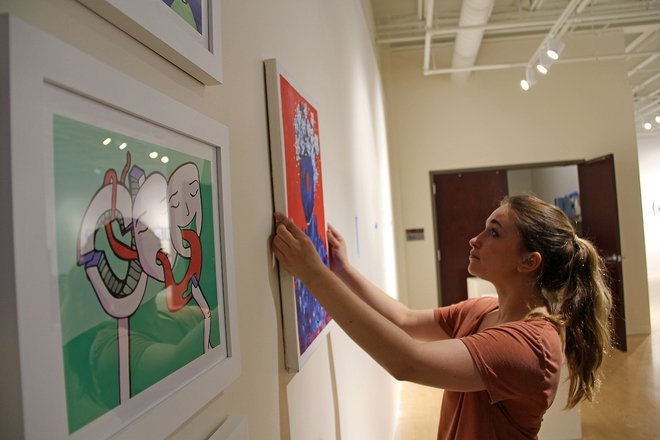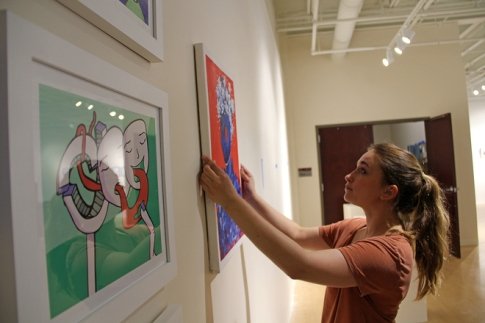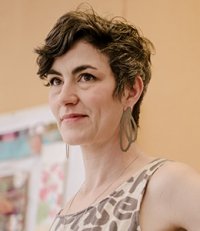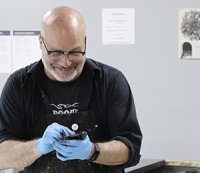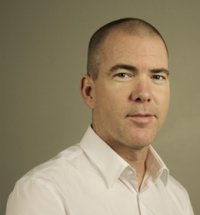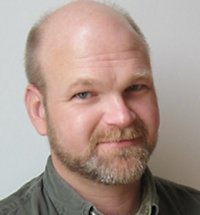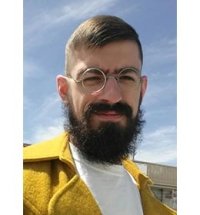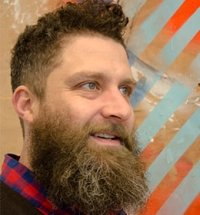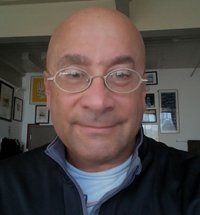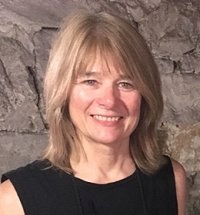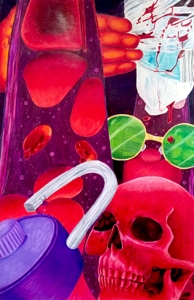
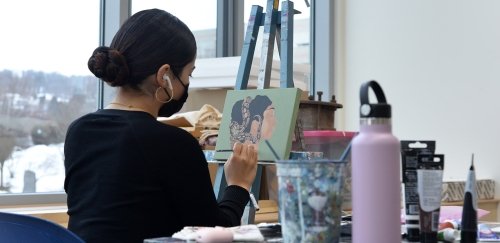
Visual Arts (B.A.)
The most advantageous training for an artist, particularly in today's constantly changing technical environment, is a foundational understanding of art theory and practice and the appreciation of art as a humanistic, academic discipline.
- Degrees & Offerings
-
- B.A.
- Department
- Program Contact
-
Chair of the Department of Art and Art History, Professor
-
Office Assistant
Students pursue art studio for many reasons, including self-expression, to learn an artistic process and to pursue a vocation in the field. Studio course offerings include graphic design, drawing, fabric design, painting, photography, printmaking and sculpture. Students, both in studio art and those with other majors but similar creative interests, may develop skills that will be a deep source of personal satisfaction now and throughout life. The latter takes place particularly in the critiques, the in-depth class discussions of the work the class has accomplished. In the studio courses, students learn the discipline and technical processes for creating art as well as the aesthetic principles associated with that medium.
Bachelor of Arts in Studio Art Degree
This degree offers eight areas of concentration — each supervised by a specific faculty member.
- Art History
- Drawing
- Fabric Design
- Graphic Design
- Painting
- Photography
- Printmaking
- Sculpture
All Studio Art students are required to take, at a minimum, a series of three studio courses beyond the required foundation core within one area of concentration. Art Studio courses meet five hours per week and require a minimum of four hours of work outside of class per week.
Admission in the Art Studio Major does not require a portfolio.
- Course Descriptions
- Requirements
- Sequence Sheets: Art History Concentration, Graphic Design Concentration, Studio Art Concentration
- Advisement Worksheet
Courses and Curriculum
Nine concentrations of Visual Arts BA are available.
Art history involves understanding these works of creativity through the ages and across diverse cultures. Such an understanding entails not only developing a basic visual vocabulary of great works of art and architecture past and present, but also the capacity to articulate their appearance, to describe and discuss the cultures they evidence and to explore the ideals and practices of their times. The museum and the library are the studio of the art historian.
The Digital Media Concentration includes courses in digital photography, digital drawing and painting, animation, and video art.
A dramatic interplay of lines, tones and marks

In the Drawing Concentration, students move from an introductory experience that emphasizes perceptual skills to an advanced experience that privileges a nuanced and complex understanding of the implications of style and materials, as well as a specific and personal content.
Introductory Drawing
Students examine and practice the fundamentals of graphic description, and visual language in general. Students become familiar with a variety of black and white drawing materials, and they look at the many uses and different expressive methods of drawing. In addition to doing studio work focused on observation and perceptual skill development, students become familiar with a variety of significant artists and movements (including some non-Western traditions).
Intermediate and Advanced Drawing
Students continue to hone their graphic and perceptual skills, and they begin to develop their own individual styles, conceptual bases, and expressive interests. Students at the intermediate level do substantial work with color drawing materials, and further examine content areas such as the human figure, interior space, and still-life arrangements. Students at the advanced level respond to structured assignments in the studio, while developing their own focused body of work outside of the classroom. Advanced students respond to a series of written assignments geared toward strengthening their individual conceptual frameworks and expressive modes.
Drawing Studio Usage Information
Our Drawing facilities are available for students currently enrolled in a Drawing course.
Facility
Our large drawing studio has all of the tools necessary for students to create works of any size an medium including drawing horses, chalkboard, lights, drafting tables, projectors and sinks for clean-up. Our studio also features a vast selection of materials for the use of creating diverse and interesting still lives.
Faculty
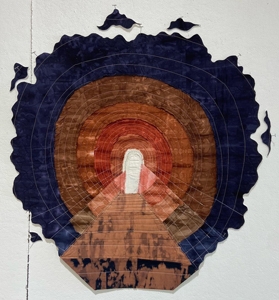
Infusing flowing fabrics, vibrant dyes and intricate stitching
Within the concentration of Fabric Design, students will explore the meaning, purpose, and significance of fiber art and textile design. Fabric Design offers students comprehensive instruction in surface design and dye techniques. Courses encompass: direct application of dye and textile pigment, repeat pattern design, starch resist methods including potato dextrin, Pre-sist and water based wax techniques, silk painting,
Japanese Shibori, photo silk screen and “deconstructed” printing on fabric, color-removal, alternative fabric design, non-woven vessel forms, soft sculpture, felting, dye color theory using MX Fiber Reactive Dyes and Wash fast Acid Dyes, embellishment, studio art quilts, wearable art and digital printing on fabric.
Fabric Design Lab Usage Information
Our Fabric Design facilities are open to all students currently enrolled in a Fabric Design course. Upper level students have 24/7 access.
Facility
The fabric design studio contains seven 4’ x 8’ professional padded print tables, high ceilings and southern exposure which allow bright, natural, warm light in all day. Studio equipment consists of and AWT Pro-Light silk screen exposure unit, a Jacquard Vertical Fabric Steamer, six Bernina sewing machine, three Lenovo PC computers, a HP Scanjet 4070 Photo-smart scanner and a HP deskjet 70 medium format printer for digital printing on fabric.
Faculty
Crossover and interplay between print & interactive design
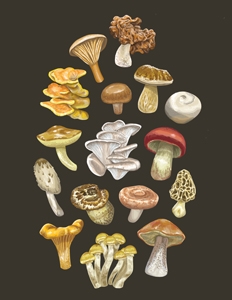
The Graphic Design concentration provides students with a broad set of skills in a variety of digital media. Students investigate current trends in technology as they explore innovative and conceptual approaches to graphic design that includes the crossover and interplay between interactive web and print/book design. Intensive study that focuses on advanced image manipulation, time based sequencing, narrative structures, and interactive design prepare students with practical experience in a variety of digital areas. Students work toward developing a cohesive body of work that represents a personal vision relevant to current design culture.
Digital Art Lab Usage Information
The Art Tech Lab has monitored open lab hours that are scheduled and posted at the start of each semester. The lab is available for use by registered digital art students, students concentrating in digital art, or by permission from the digital art faculty.
Facility
The Art Tech Lab, is a fully equipped Mac lab dedicated to the Department of Art & Art History. This state-of-the-art digital lab is on a 3-year replacement cycle and is currently equipped with twenty 27” iMac computer stations installed with Adobe Master Collection (CC), each has a Wacom drawing tablet. The Art Tech Lab has one large format and two standard sized flatbed scanners, a Xerox Phaser 7500 12x18 duplex color laser printer, and two Epson large format printers; Stylus Pro 4880 and Stylus Pro 7800. In addition, the lab is equipped with a digital projector, large worktables with cutting surfaces, and a large critique wall with track lighting for presentation of printed projects. Additional equipment includes Nikon digital cameras with video capabilities, tripods, USB card readers, light tables, a Kutrimmer bookboard cutter, and miscellaneous binding equipment.
Faculty
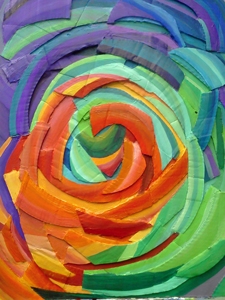
Addressing traditional and contemporary techniques
At the Introductory level Painting students are introduced to a variety of technical, historical and conceptual approaches to the medium. Students are encouraged to work independently pursuing their personal vision, and also encouraged to work through a variety of directed exercises to explore different approaches to form. At the Intermediate and Advanced levels, students work more independently to develop a unique body of work.
Instruction is highly individualized, and students are required to pursue research intended to help enhance the content and to help contextualize their work. Students are asked to write and speak coherently about their work within this broader context. These skills enable the student to prepare and present their portfolio in a professional manner.
Painting Studio Usage Information
Our Painting Studio is open to any student currently enrolled in a Painting class.
Facility
The Painting area is composed of two areas totaling 1,430 sq ft. The painting room has high ceilings and lots of natural light, and a 253 sq ft framing room. These areas are equipt with:
- 26 Steel easels
- a gesso area
- Storage racks
- Sinks
- Halogen Lights
- Slide Projector
- Opaque Projector
- Plastic and Glass pallets
- compound miter saw
- TV/VCR
- Solvent Dispenser
- Miscellaneous Tools
- Still Life Materials
There is also access to a portable blackboard, and a portable digital projector and laptop computer. Students are furnished with some supplies such as staples and gesso.
Faculty
Harnessing light to produce powerful images
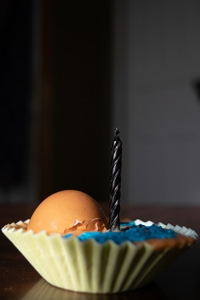
The photography program in the Department of Art and Art History offers a comprehensive experience for the interested student. Courses offered include darkroom, digital, portraiture, experimental, landscape, and street photography. Facilities include a complete chemical darkroom, fully equipped Mac lab with 24” and 44” wide Epson printers, and a dedicated lighting studio. Students are encouraged to take advantage of the numerous opportunities offered through the department such as internships, independent study projects and study abroad along with the regular course offerings. These opportunities enable photographers to develop their portfolios and gain professional experience before graduating. With close proximity to New York City and Philadelphia, photography majors have many opportunities to view and study the work of artists relevant to their own photographic interests.
Photography Darkroom Usage Information
Our Photography facilities are only available for students currently enrolled in a Photography course.
Facility
The photography facilities in the Department of Art include a chemical darkroom dedicated to black & white printing with fifteen enlarger stations. Each station is equipped with a new Beseler 23CIII enlarger, filters, grain focuser, and easel. The darkroom also includes an open studio work area. The digital lab 3-year replacement cycle for twenty 27” Mac computer stations with Adobe Creative Cloud applications. The lab includes a flatbed scanner and multiple large format Epson printers that can print 24” or 44” wide. The lighting studio has numerous backdrops and a set of Alien Bee strobe lights with various accessories such as umbrellas, honeycombs, and gels. The photography program provides chemicals and some equipment for student use.
Faculty
Sophisticated processes with beautiful results
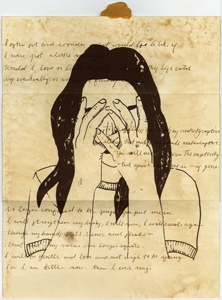
Our printmaking concentration offers the student a contemporary approach to non- toxic printmaking. At the introductory level, students may take three individual courses including Intaglio (etching and collagraph techniques), Silkscreen, and Waterless Lithography and Relief printmaking. In each class, the student will learn in-depth technical skills while exploring conceptual ideas.
After the student has completed at least two of the introductory level print courses they may enroll in Advanced Printmaking. In this class, students work more independently, concentrating on their focused body of work.
Experimentation is highly encouraged, including multiple techniques/ layers, the use of alternative surfaces/ materials, print installations and sculptural works. The advanced class is preparation for the real world. Each student will complete a cohesive body of prints, write an artist statement and give a professional artist lecture to a group outside of their own class.
Why don't you check out the Bloomsburg University Printmaking page on Facebook?
Printmaking Lab Usage Information
The Printmaking studio is open to all students enrolled in a printmaking class. Upper level students have 24/7 access. Intro students have monitored lab hours.
Facility
Our well-equipped darkroom includes facilities photo-intaglio, photolithography and photo-silkscreen. There is a new 26”x36” Ovac OV 29 accuvac exposure unit (plate exposures), and a new Workhorse metal halidade point light source silkscreen exposure unit as well as plenty of space for plate/ screen prep and development. The studio has its own digital lab. It contains an Epson 7800 large format printer, a new zante plate maker for producing positives and polyester plates, a large format flatbed scanner, a slide scanner, and three Power Macs.
The intaglio section includes 3 etching presses: 30”x48”, 26”x48” and 22”x43”. We also have a 48” wide metal plate cutter, numerous large glass slab work areas, a set of three viscosity rollers for plates up to 20x 20, two ferric chloride vertical etching tanks that accommodate 20”x24” copper, a 24”x36” hot plate, drying cabinet, airbrush and spray booth.
The silkscreen area has a 42”x33” light table, two 46”x30” drying racks, a 50”x60” vacuum table and 20 portable printing stations, a 30” wide Challenge industrial paper cutter, power washer and a backlit wash-out unit with separate ventilation.
Faculty
Exploring new materials and fabrication techniques
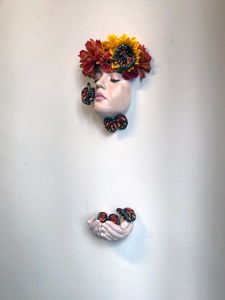
The Sculpture Program at Bloomsburg University of Pennsylvania provides a balance of craft and concept development. Students can model, manipulate, cast, fabricate and construct sculptural environments. The courses in sculpture introduce students to a variety of concepts, materials and processes aimed at providing a knowledge base that students can rely upon as they continue to develop. Upper level classes continue to build skills while providing the students with an understanding of how their practice fits into the larger discussions within the contemporary art world.
Sculpture Studio Usage Information
Our Sculpture facilities are only available for students currently enrolled in a Sculpture course.
Facility
The Sculpture Studio includes a welding fabrication / forging area, an area for casting and mold making, and a wood shop furnished with high quality hand and power tools, dust collection and compressed air for pneumatic tools. Future initiatives include public art, new media, and installation art.
Faculty
The Husky Difference
Art Studio Faculty
Applying to this Program
Apply
-
Application Process
Review the step-by-step process whether you're a first-year student, transferring to BU, or more.
-
Apply Now
Ready to apply? Great!! Start your online application here.
Explore More
-
Explore Bloomsburg
There's no better way to learn more than to experience Bloomsburg for yourself! Set up a campus tour or connect with us virtually.
-
Connect with Your Admissions Counselor
Applying to college is a big step. You have questions, and we have answers!
-
Financial Aid Guide
Our Financial Aid team is your guide to navigating the aid process here at BU.



